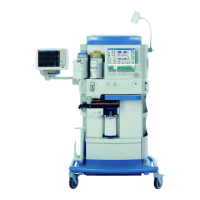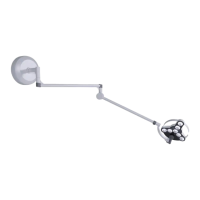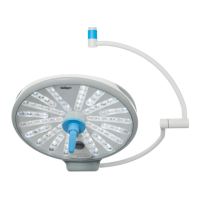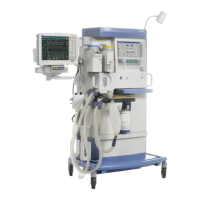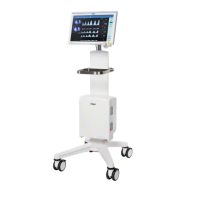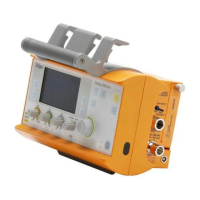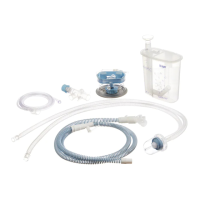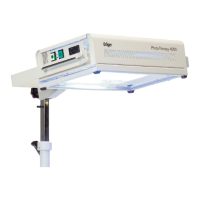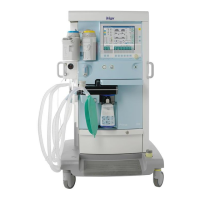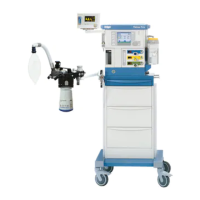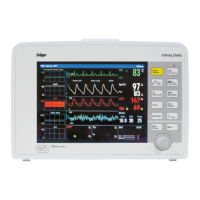What to do if Dräger Perseus A500 Medical Equipment has a power failure?
- Jjason14Aug 14, 2025
If there is a power failure, restore mains power supply.
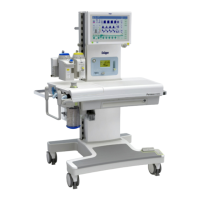
What to do if Dräger Perseus A500 Medical Equipment has a power failure?
If there is a power failure, restore mains power supply.
What to do if Dräger Perseus A500 Medical Equipment has a mains power supply failure and empty batteries?
If you experience a mains power supply failure and empty batteries, take the following steps: * Check the vaporizer setting. * Set the O2 switch (A) upwards to position _Add. O2._ * Open the flow control valve (B) on the O2 flowmeter and set the desired flow. * Charge empty batteries for at least 8 hours. * Check the displays for mains voltage and battery on the status display. * For devices without isolation transformer: Replace the fuses. * For devices with isolation transformer: If necessary, wait at most 2 minutes for the circuit breaker to cool. Press the key on the circuit breaker back in or operate the switch on the isolation transformer.
What to do if Dräger Perseus A500 Medical Equipment has a ventilator failure?
In the event of a ventilator failure: * Switch to the MAN / SPON ventilation mode. * Manually ventilate the patient.
What to do if Dräger Medical Equipment has a failure of fresh-gas delivery?
If there is a failure of fresh-gas delivery, ensure the patient receives O2 using emergency O2 delivery. Check the vaporizer setting.
What to do if Dräger Perseus A500 Medical Equipment has a screen fault/user interface failure?
If the screen or user interface fails: * Switch Perseus to Standby mode by pressing the button and confirming with the rotary knob. * Manually ventilate the patient.
What to do if Dräger Medical Equipment has a failure of the gas measurement?
If the gas measurement fails, ensure corresponding substitute monitoring. Check the sample line and water trap for damage or blockage and resolve these as needed.
What to do if Dräger Medical Equipment has problems with the anesthetic gas receiving system (AGS)?
If you are experiencing issues with the anesthetic gas receiving system (AGS), consider the following: * If the suction power of the ejector is insufficient, have the function of the AGSS terminal unit checked. Observe related instructions for use. * If the particle filter is contaminated or blocked, replace the anesthetic gas receiving system (AGS) or have service personnel replace the particle filter. * If the suction power of the ejector is too high, have the suction power of the ejector in the AGSS terminal unit adjusted to the working range of the AGS. * If the particle filter is missing, replace the anesthetic gas receiving system (AGS) or have service personnel install the particle filter.
What to do if Dräger Medical Equipment has a failure of flow measurement?
If the flow measurement fails, replace the flow sensor and perform the breathing system test.
What to do if Dräger Medical Equipment has a complete failure of the gas supply?
If there is a complete failure of the gas supply, disconnect the hoses for the failed gas from the central supply.
| Type | Anesthesia Workstation |
|---|---|
| Manufacturer | Dräger |
| Model | Perseus A500 |
| Gas Supply | O2, N2O, Air |
| O2 Flush | Yes |
| Tidal Volume Range | 20 to 2000 ml |
| Respiratory Rate | 4 to 60 breaths/min |
| Inspiratory Time | 0.2 to 5 sec |
| PEEP | 0 to 20 cmH2O |
| FiO2 Range | 21 - 100% |
| Display | Color touchscreen |
| Display Size | 12.1 inch |
| Integrated Monitoring | Yes |
| Integrated Battery | Yes |
| Ventilation Modes | Volume-controlled, pressure-controlled, pressure support, and more |
| Vaporizers | Up to 2, for various anesthetic agents |
Defines the scope of the document for specific software versions.
Explains formatting like numbering, bullet points, and bold text.
Clarifies specific terminology used in the manual, like 'accessories'.
Covers WARNING and CAUTION statements for general device operation.
Details specific warnings and precautions related to the product's features.
Describes the primary purpose and target users for the anesthesia workstation.
Outlines when the device should be used and specific situations where it is not recommended.
Provides additional details on the environments and conditions for device application.
Details the physical components and parts of the anesthesia workstation.
Outlines the device's capabilities, modes, and features.
Illustrates the pathways of gases through the breathing system.
Explains the main screen layout, including header, monitoring, and menu bars.
Describes how colors are used to indicate function availability and status.
Guides users on how to select and adjust parameters using the device controls.
Explains the functions of the remote control for ceiling-mounted units.
Details the function and operation of the safety sensor for ceiling-mounted versions.
Covers prerequisites, docking, and cable connections for ceiling-mounted units.
Provides guidelines and safety information for attaching accessories to the device.
Outlines essential steps to perform before the device's initial use.
Details precautions and procedures for moving the device within a hospital.
Guides on connecting central gas supply and gas cylinders for operation.
Explains how to properly connect and ensure the functionality of the anesthetic gas scavenging system.
Covers steps for assembling the breathing system and installing components.
Details how to choose and connect various accessories for patient care.
Step-by-step guide on powering on the anesthesia workstation.
Explains how to verify and customize device settings.
Describes how to ensure the device is ready for operation through system tests.
Provides procedures for starting the device quickly in emergency situations.
Lists critical safety warnings and precautions during device operation.
Covers procedures for initiating patient therapy, including data loading.
Explains how to modify ventilation and gas settings during therapy.
Details advanced or specific therapeutic modes like non-rebreathing systems.
Describes lung recruitment maneuvers and their parameters.
Explains specialized display fields like breathing gas measurement and xMAC.
Guides on customizing the screen layout and views.
Identifies causes and methods for locating and resolving system leakages.
Addresses issues related to mains power failure and battery operation.
Explains how to use emergency O2 delivery in specific gas mixer configurations.
Covers scenarios of central gas supply failure and actions to take.
Details procedures for handling fresh-gas delivery issues using emergency O2.
Outlines steps to take when the ventilator component fails.
Addresses issues with the gas measurement system and actions to resolve them.
Explains how to handle failures in flow measurement and sensor replacement.
Describes troubleshooting steps when the screen or interface is unresponsive.
Provides guidance for addressing total device failure.
Details common issues with the AGS and procedures for replacement.
Discusses issues related to cylinder pressure reducers and their causes.
Covers troubleshooting for the Vapor View option and its components.
Explains how to send device information to Dräger for support.
A comprehensive list of alarms, their causes, and suggested remedies.
Crucial safety warnings related to maintenance, reprocessing, and opening the housing.
Outlines procedures and warnings for transporting the device for service.
Provides definitions for key terms used in service procedures.
Details the schedule and user groups for device inspections and safety checks.
Lists components requiring maintenance, their intervals, and responsible user groups.
States that repairs must be performed by specialized service personnel.
Warnings regarding reprocessing and contamination risks before disposal.
Provides information on proper disposal of electrical and electronic devices.
Guides on disposing of accessories according to hospital hygiene regulations.
Provides general units of measurement and operating location specifications.
Lists operating and storage environmental conditions for the device and battery.
Details data standardization and specifications for fresh-gas delivery.
Provides O2 concentration and flow accuracy for the electronic gas mixer.
Lists O2 concentration and flow specifications for the mechanical gas mixer.
Details time-based settings and parameters for the ventilator.
Provides volume, compliance, and leakage data for breathing system components.
Specifies connection, delivery, and pressure limitation for the external outlet.
Details suction flow rates and maximum fresh-gas flow for the AGS.
Lists specifications for airway pressure, volume, and flow measurements.
Provides ranges and accuracies for calculated values like consumption and uptake.
Covers power supply, consumption, and general operating parameters.
Details serial interface, USB, and LAN interface specifications.
Lists applicable IEC and ISO standards the device complies with.
Includes pressure and flow characteristics of the breathing system.
Outlines requirements for operating the device with other equipment.
Covers electromagnetic compatibility and immunity test levels.
Explains how to connect the device to IT networks and supported protocols.
Provides information on open-source software used and where to find details.
Explains various ventilation modes available on the device.
Details the function of each therapy control on the device.
Describes different levels of respiratory support provided by the device.
Lists ventilation modes and their associated parameters.
Explains the minimum O2 delivery function and its configuration.
Describes how patient data affects device settings and calculations.
Covers support for Infinity ID accessories and their functionality.
Explains the features enabled by Infinity ID accessories.
Illustrates alarm priorities and tone sequences.
Details how to open and change the combination lock on the drawer.
Lists and explains abbreviations used throughout the manual.
Provides explanations for various symbols used on the device and in the manual.
Explains the meaning of different product labels found on the device and packaging.
Maps the main menu buttons to their corresponding dialog windows and tabs.
Specifies the default configuration password and information on its use.
Details the password's purpose, length, and security recommendations.
